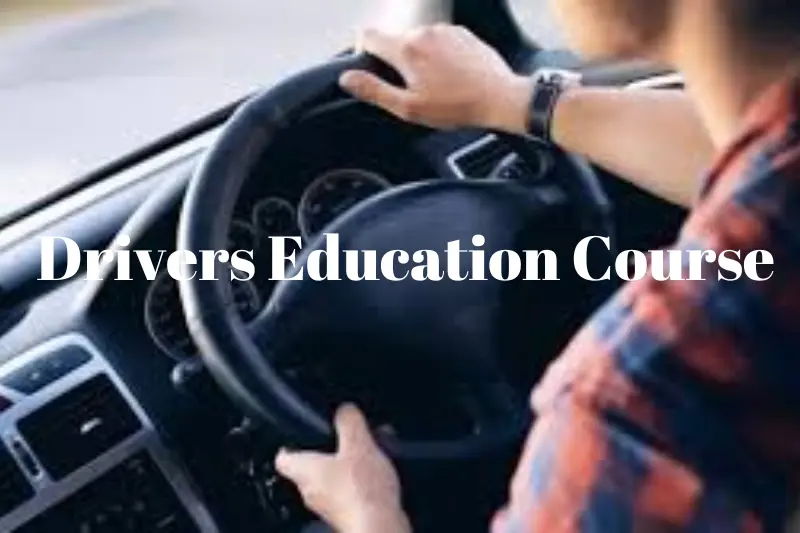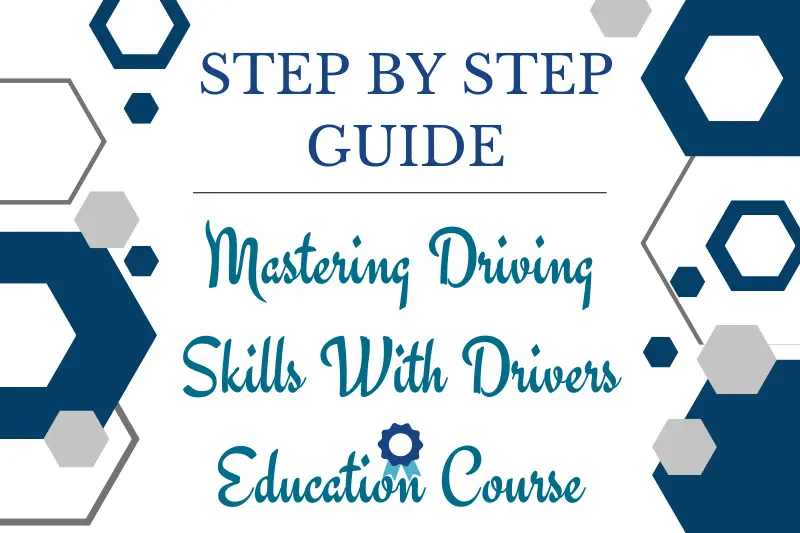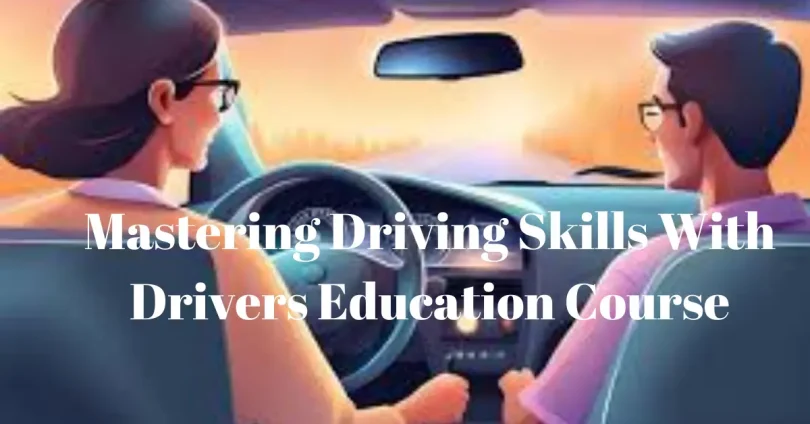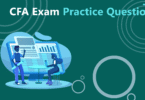Introduction
Drivers Education Course is one of the best ways to learn how to drive safely and confidently. It provides step-by-step training on traffic rules, road signs, and practical driving skills. Whether you are a beginner or looking to improve your driving, this course helps build a strong foundation.
Today, many people are turning to professional training instead of learning casually. According to recent Educational News, there is a rising awareness about the importance of safe driving and formal driver education. These courses are not just about passing the driving test, but about becoming a responsible driver for life.
With the rise of tech & education, driving courses have become more interactive and flexible. From online lessons to digital driving simulations, technology is making it easier and more effective to learn. Now, students can access quality driving education from anywhere, at their own pace.
Drivers Education Course

A Drivers Education Course, often known as driver’s education or driving school, is a formal training program designed to teach individuals how to drive safely and responsibly. This course is generally required by law in many regions for first-time drivers, especially teenagers, before they can receive a driver’s license.
- The course covers both theoretical and practical components. The theoretical part focuses on traffic laws, road signs, driving ethics, and safety measures. The practical part includes behind-the-wheel training with a certified instructor where students learn how to handle the vehicle, maneuver on the road, and deal with real-life driving situations.
- There are different formats of Drivers Education Courses available today. These include classroom-based courses, online courses, and hybrid models. The online option has gained popularity in recent years due to its flexibility and convenience. Students can learn at their own pace, review lessons multiple times, and even practice through simulations.
Key components of a Drivers Education Course
- Traffic laws and road signs
- Safe driving habits
- Understanding road conditions and weather-related driving
- Defensive driving techniques
- Vehicle handling and control
- Emergency responses
- Parking and reversing skills
- Night driving and highway driving
- Alcohol and drug awareness
- Final written test and driving test
This course is usually offered through public high schools, private driving schools, or certified online platforms. Some insurance companies even offer discounts to students who complete a certified Drivers Education Course, recognizing that trained drivers are less likely to be involved in accidents.
Overall, the goal of the course is not just to help you pass the driving test but to prepare you for a lifetime of safe driving. It instills discipline, responsibility, and awareness among new drivers which are essential for maintaining road safety.
Why Is Drivers Education Course Important ?
Understanding the importance of a Drivers Education Course is crucial. It’s more than just learning how to steer a car or follow traffic signals. This course plays a vital role in shaping responsible drivers and reducing road accidents.
Here are several reasons why a Drivers Education Course is important:
Builds Strong Driving Foundation
- Teaches new drivers essential skills and road knowledge
- Instills good driving habits from the start
Increases Road Safety
- Reduces the risk of accidents
- Helps drivers learn defensive driving techniques
Boosts Confidence
- Builds confidence in driving through supervised practice
- Prepares learners for various driving situations
Fulfills Legal Requirements
- In many states, it is mandatory for young drivers
- Helps meet licensing requirements efficiently
Promotes Responsible Driving
- Encourages discipline and focus
- Emphasizes the importance of following traffic laws
Reduces Insurance Premiums
- Certified courses can help lower car insurance costs
- Insurance companies prefer trained drivers
Helps Identify and Correct Mistakes
- Instructors can guide and correct poor driving behavior
- Prevents the development of bad habits
Covers Emergency Situations
- Teaches how to handle unexpected road scenarios
- Includes lessons on first-aid, vehicle failure, and weather conditions
Improves Theoretical Knowledge
- Helps pass written driving exams
- Enhances understanding of road signs and rules
Encourages Long-Term Safe Driving
- Prepares drivers for a lifetime of cautious driving
- Builds awareness and responsibility on the road
Advantages Of Education And Disadvantages
Like every educational system, Drivers Education Course also has its own set of advantages and disadvantages. Let’s discuss them in detail.
Advantages of Drivers Education Course
| Structured Learning The course provides a well-organized way of learning how to drive, covering both theoretical and practical aspects systematically. |
| Promotion Of Responsible Behavior The course emphasizes ethical and responsible driving habits from the beginning. |
| Better Performance In Driving Tests A well-trained student is more likely to pass driving exams on the first attempt. |
| Preparation For Real-World Scenarios The training covers handling emergencies, difficult weather, or unusual road conditions. |
| Awareness Of Rules And Regulations It ensures that learners are fully aware of legal responsibilities and driving laws before they hit the road. |
| Insurance Discounts Many insurance providers offer discounts to students who complete certified drivers education courses, making it financially beneficial. |
| Flexible Learning Options Online and hybrid courses allow students to learn at their own pace, which is especially useful for those with busy schedules. |
| Confidence Building The course helps reduce nervousness and anxiety, making learners more confident behind the wheel. |
| Experienced Guidance Certified instructors provide valuable insights and tips that you cannot learn from self-practice or untrained teaching. |
| Improved Road Safety Trained drivers are more aware of traffic laws, resulting in fewer accidents and better decision-making on the road. |
Disadvantages of Drivers Education Course
| False Sense Of Security Some students may overestimate their abilities after completing the course, leading to risky behavior. |
| Certification Issues Not all courses are certified by authorities or recognized by insurance companies. |
| Mismatch With Real Road Conditions Simulations or classroom learning may not fully prepare students for actual road conditions. |
| Overdependence On Instructors Some learners may become too reliant on instructors and face difficulties when driving alone. |
| Instructor Quality Varies The effectiveness of the course may depend on the skill and attitude of the instructor. |
| Online Course Limitations Lack of hands-on experience in fully online courses can be a disadvantage. |
| Not A Substitute For Experience Book knowledge can’t replace real road experience gained over time. |
| Limited Personalization The course may not always cater to individual learning speeds or challenges. |
| Time-Consuming Completing the full course requires dedication and time, which some may find inconvenient. |
| Cost Factor Some courses can be expensive, making it less accessible for everyone. |
A Step By Step Guide To Drivers Education Course

Step 1: Research Available Courses
- Look for certified schools or online platforms
- Compare costs, curriculum, and reviews
Step 2: Register For The Course
- Choose a course that fits your schedule and learning style
- Complete the enrollment process and pay fees
Step 3: Start Theoretical Learning
- Learn traffic rules, signs, and driving laws
- Study safety guidelines and defensive driving techniques
Step 4: Attend Practical Lessons
- Practice behind-the-wheel with a certified instructor
- Learn steering, braking, reversing, and parking
Step 5: Practice Regularly
- Practice driving outside the class with supervision
- Try driving in different conditions like night, rain, and traffic
Step 6: Take Internal Assessments
- Complete quizzes and mock driving tests
- Get feedback from your instructor
Step 7: Complete Course Requirements
- Finish required theory hours and practical lessons
- Ensure attendance and assignment submissions
Step 8: Schedule Official Driving Test
- Book your test with the local licensing authority
- Revise important concepts and practice test routes
Step 9: Pass The Written And Road Test
- Take the written test for theoretical knowledge
- Appear for the road test with a licensed examiner
Step 10: Receive Your License
- On successful completion, receive your driver’s license
- Celebrate responsibly and continue practicing safe driving
Challenges And Their Solutions
Challenge 1: High Course Fees
Solution: Look for affordable or government-supported programs, scholarships, or discounts.
Challenge 2: Nervousness During Driving
Solution: Start with less busy roads and increase difficulty gradually with instructor support.
Challenge 3: Time Management
Solution: Choose flexible online courses or weekend batches.
Challenge 4: Language Barriers
Solution: Select courses available in your preferred language or seek instructors with multilingual support.
Challenge 5: Inconsistent Learning Pace
Solution: Revisit theory lessons, ask for extra practice time, or switch to personalized coaching if needed.
Future Of Drivers Education Course
- The future of Drivers Education Course looks promising and more tech-enabled. With advancements in tech & education, new tools such as virtual driving simulators, mobile apps, and AI-based coaching are being used to enhance the learning process.
- Online learning platforms are making driver’s education more accessible. Self-paced modules, gamified learning, and interactive videos are gaining popularity. In the future, we may see full-fledged VR-based driving schools where students can practice without being on real roads.
- Additionally, integration of electric vehicle training and sustainable driving techniques will also become a part of modern courses. The focus will continue to shift from just passing tests to creating eco-conscious and tech-savvy drivers.
Frequently Asked Questions
What is a Drivers Education Course?
It is a structured program that teaches driving skills, road safety, and traffic laws to new drivers.
Is it mandatory to take a driving course?
In many regions, yes, especially for teenagers. It may also be required for adults in some areas.
How long does the course take?
The course typically lasts 4 to 8 weeks, depending on the format and schedule.
Can I take the course online?
Yes, many certified platforms offer online or hybrid driving courses.
Do I need my own car for the course?
Not always. Most driving schools provide a training vehicle.
What is the minimum age to enroll?
Usually 15 or 16 years, depending on your state or country’s rules.
Does it help reduce insurance costs?
Yes, many insurance providers offer discounts for certified course graduates.
What is taught in the theory part?
It includes road signs, traffic rules, safe driving practices, and emergency handling.
Is it better to learn from a family member or instructor?
A certified instructor provides professional training that family members may not offer.
What if I fail the driving test?
You can retake it after a short waiting period and more practice.
Conclusion
A Drivers Education Course is more than just a step toward getting a license. It is a foundation for safe, confident, and responsible driving. With growing traffic and road risks, this structured learning has become more important than ever. Whether you are a teenager or an adult learner, investing time in a Drivers Education Course can shape your driving journey in a positive way. Like Educational Toys for 3 Year Olds prepare kids for the future, this course prepares you for safe and successful driving. With the help of tech & education, it’s now easier and more efficient to become a skilled driver.
Ten Bonus Tips For Drivers Education Course
- Start with calm and clear roads
- Practice daily, even for a short time
- Understand road signs thoroughly
- Use driving simulators if available
- Ask questions to your instructor
- Learn from your mistakes
- Stay calm during the driving test
- Avoid distractions like mobile phones
- Drive with focus, not speed
- Never stop learning, even after getting a license







